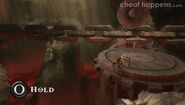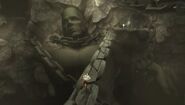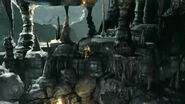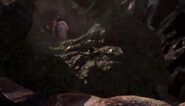
This article contains lore based on real-life sources of the Greek mythology as introduced from the God of War Greek era.
| “ | Here is where the souls of the wicked are tortured in the pits of Tartarus, the wailing and agony of the damned, resonated deep throughout the bowels of the Underworld. | ” |
–Gaia | ||
Tartarus (Greek: τάρταρος) is the Primordial entity of the Abyss and one of the first children of Chaos, brother to Gaia and Nyx and is also the deepest part of the Underworld, where most of the Titans were imprisoned by Zeus after their defeat in the first Titanomachy.
Greek Mythology
In Greek Mythology, Tartarus was the darkest depths of the Underworld. It was where the souls of the evil were sent to for eternal torture, and was where Zeus imprisoned the Titans. In Greek Mythology, Tartarus was a part of Gaia, near the regions of her stomach, while in other variations of Mythology, Tartarus was also a Primordial like Gaia and Nyx, born of Chaos. He made love to Gaia as well and Gaia gave birth to Typhon as a result.
Tartarus was envisaged as the opposite of the sky, an inverted-dome that lain beneath the Earth. Together, the Ouranion-dome and Tartarean-pit enclosed the entire cosmos in an egg-shaped or spherical shell.
God of War Series
Tartarus is the primordial abyss, both as an endless domain and a male Protegonoi diety, born out of Chaos like its siblings Nyx, Erebus, Ouranos, Eros and Gaia. Its not known what role he played, if any during the Primordial War where Ouranos ultimately prevailed, assuming lordship over creation and taking Gaia as his consort and queen.
When it sprang forth from Chaos before the beginning of time, Tartarus was a dimension, separated from the upper realms by dimensional barriers. This remained that way until the Titan Hyperion shattered these barriers with the Power of the Sun, which merged the dark and fiery chtonic realms with the World of Man and Gods.
The God of the Pit doesnt involve himself in the wars and political affairs of the Gods in the upper world above, except for allowing his domain of torment and damnation to be used as a prison for the immortal deities, but it is doubtful that Tartarus would have any objections to that.
Among his captives were the mighty Hecantonchires and Elder Cyclops that were thrown into his fiery abyss by their father Ouranos. Their stay in his realm would go on for many ages until the young Zeus freed his ancient uncles and later threw a great number of Titans into the realm, binding and enchaining them to the giant rocks and mountains of the dark realm with the Gauntlet of Zeus.
Tartarus didnt resist and stand in the way when the Hecatoncheries were freed, as he only holds his prisoners as long the ruling pantheon can enforce their sentences, he himself wont take sides in any conflict.
The same passiveness was seen when the Goddess Persephone released the Titan Atlas from his domain, which shows that the ancient God isnt beholden to any ruling pantheon and will not make any effort to ensure their enemies remain imprisoned.
However, once he has been known to be seduced by Gaia to concieve the powerful Storm-Titan Typhon, meant to overthrow the Gods and destroy Zeus in his mothers name. As a physical realm, Tartarus is endless and infinite much like the Sky, its celestial counterpart. The Gates of Tisiphone were one of the only, if not the only entrance that a mortal could use to enter the primordial realm.
God of War: Ascension
In this game it is revealed in the description of the Blades of Chaos, that they were forged in Tartarus itself. The novelization of the first God of War, reveals the creator to be none other than the God of Blacksmithing, Hephaestus who forged the wicked Blades on the behalf of his brother Ares.
God of War: Chains of Olympus
In God of War: Chains of Olympus, Kratos was defeated by Charon, and subsequently thrown into Tartarus. As he attempted to make his way out of the depths, Kratos fought his way through hordes of enemies and came across the prison of Tartarus.
In the dark caverns of Tartarus the souls of the wicked can be seen, enchained and tormented for eternity. Their screams fill the dark realm. Kratos fights his way through until he reaches the imprisoned Titans, bound in their chains.
During the beginning of their reign, the Olympians have took control of the chtonic realms and with them the entire Afterlife, with the eldest son of Cronos, Hades becoming the God of the Underworld and eventually, the Three Judges, sons of Zeus directing mortals into separate eternal afterlifes, including Tartarus. Around that time they assigned a Jailer to watch over the prisoners and the Temple of Zeus, housing the mighty Gauntlet of Zeus. Now, Kratos encounters the Jailer of Tartarus dead on his throne and gains access to the powerful weapon.
Eventually the Spartan finds a way back to the Underworld, to the banks of the River Styx where he goes on to face Charon and take his boat.
God of War III
In order to craft a special weapon for the Spartan Warrior, Hephaestus told Kratos to retrieve the Omphalos Stone. The stone, however, was said to dwell deep within the Pit of Tartarus, deep below The Forge. In the caverns, on his way his to the doors, Kratos witnessed the freed souls of the Underworld in search of their redemption that was nowhere to be found. Then, Kratos reached the Gates of Tisiphone, which he needed to solve the puzzle of the doors that lead him to the Pit of Tartarus. He then battled his way through its darkest depths, until he ultimately came face-to-face with Cronos. After a vicious battle, Kratos slew Cronos, retrieved the Omphalos Stone, took it to Hephaestus, and received the Nemesis Whip.
God of War: Ragnarök
The fires of Tartarus within the Blades of Chaos, are recognized and referred to as "Primordial Fire" by the legendary Fire Giant Surtr, who recognizes its ancient nature and power as similar to his own Primordial Fire thats dwelling within him and his realm. In order to become Ragnarok, Surtr draws the power and fire of Chaos and Tartarus from the dark and wicked Blades, once forged by the Smith God Hephaestus. The process is successful and transforms the weary and old Fire Jötuun into a realm-destroying cosmic giant.
God of War Ragnarök: Valhalla
While not appearing, Tartarus was mentioned when Kratos tells Mimir that souls who are deemed wicked are casted down into the primordial abyss with the latter noting that it is where the souls of the damned were tortured.
Objects/Treasures
Gallery
Trivia
- In God of War III, Tartarus was limited by an infinite stone ceiling, but there was a big hole on a part of it. Sunlight entered Tartarus through it, which indicated it lead to the surface and was an exit to the Mortal World. It was unknown why it existed or if it was made by someone, but it seemed to be large enough for a God or even a "small" Titan, like Typhon, to go through and seemed to be very old. It may have been used by the Gods who threw the Titans deep into Tartarus, for example. That hole could be seen by reading the book inside Tartarus, near Cronos location, and using the camera to look up.
- The hole could also be a referrence to the battle between Zeus and Monoetius, the twin brother of Atlas with equal strengh. He was blasted by Zeus into Tartarus when they fought in Greek mythology.
- It's revealed in God of War III, that Tartarus was actually the legendary battleground between the Gods and the Titans, though in God of War II, Atlas claimed the Great War forged the landscape of the Mortal World and not the Underworld.
- The Blades of Chaos were forged by Hephaestus in the deepest forges of the Underworld, the Blades drawing from the power of Chaos itself. The fires of Tartarus are the default divine power wielded by the Blades of Chaos, though it is not limited to it as seen in God of War: Ascension.
| |||||||||||||||||||||||||||||
| |||||||||||||||||||||||||||||
| |||||||||||||||||||||||||||||
| |||||||||||||||||||||||||||||

















